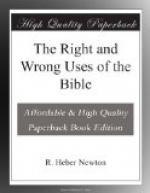And lo! this Jewish proverb is the first proof-text generally quoted for the dread doctrine that after death there is another life, but that its character is fixed forever by the state of the man at death; the dogma of everlasting conscious suffering in Hell!
What Midsummer Night’s Dream reasoning, turning common-sense topsy-turvy, and treating the words of God in the very reverse way from that in which all sane people agree to treat the words of man!
IV.
It is a wrong use of the Bible to disregard the chronological order of its parts in constructing our theology.
We are not to read the Biblical writers as though they were all cotemporaries. They are separated by vast tracts of time. The later writers stand upon the shoulders of their predecessors and see further and clearer. We are not to view the institutions or doctrines of the Bible as though, no matter in what period of the development of the Hebrew Nation or of the Christian Church they are found, they were equally authoritative upon us. That would be to say that green apples are as good food for us as ripe ones. The time-perspective is essential to set any Biblical institution or dogma in the true light.
Romanists and our own Ritualists entrench their sacerdotalism behind the priestly system of the Jews. As though, because that was once needful and serviceable to an ignorant, half heathen people, it was still indispensible to us. As though what providence once ordained, providence perpetually imposed on humanity. Such a rule would keep us with our primers always in our hands. Progress is marked by the debris of discarded institutions, wholesome and necessary once, but incumbrances after a time. The whole rationale of sacerdotalism is exploded by this simple common sense principle; and we see in its light the significance of Paul’s impatient sweeping away of the Law; of the entire ignoring of the sacrifice and the priesthood in the life and teaching of Jesus himself.
“The hour cometh when
ye shall neither in this mountain,
Nor yet at Jerusalem, worship
the Father. God is spirit;
And they that worship must
worship him in spirit and in truth.”
Dogmas also must be seen in historical perspective. Thus, for example, the doctrine of the Second Advent, which still exercises the Christian mind, is wholly cleared up as looked at through the time-vista.
We see the progress of the Messianic expectation through the centuries immediately prior to the age of Christ, in our old Testament books and in the Apocryphal writings. In these latter works we see it gradually gathering round itself visions of the winding up of the present aeon, the renovation of the earth, the judgment of the nations, the resurrection of the pious dead, and the opening of a millenial era in which the Messiah should rule the world from Jerusalem. It would appear to have even developed the notion that the Messiah, after his appearance on earth, would depart into the spirit-world, to consummate his preparation; and would return thence to assume full power. This had became the popular expectation by the Christian era.




